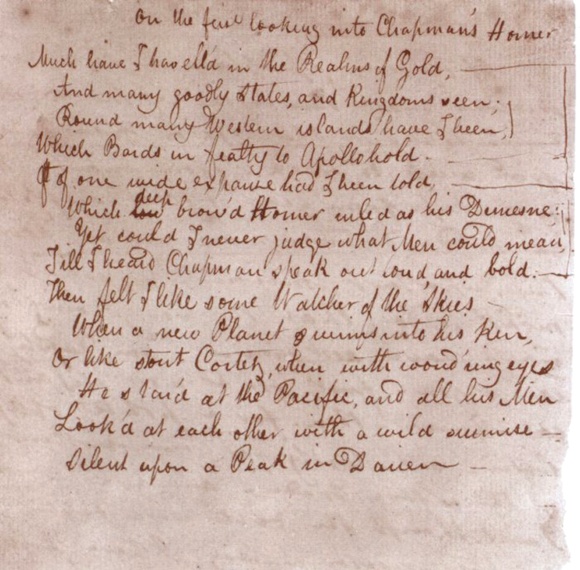John Keats, selected poems Contents
On First Looking Into Chapman’s Homer: Language, tone and structure
Language and tone of On First Looking Into Chapman’s Homer
 This is the first of Keats’ poems in which emotion is fully controlled and sustained throughout the verse – so it is even more remarkable that Keats wrote this poem so quickly, making only one alteration (‘low brow’d Homer’ became ‘deep brow’d’). The diction is expertly handled. The sense of openness to a vast sea of wonder is suggested by long vowels: ‘wild’, ‘surmise’, ‘silent’, the sense of wondering tapering off into the unstressed syllables of the poem’s final word ‘Darien’.
This is the first of Keats’ poems in which emotion is fully controlled and sustained throughout the verse – so it is even more remarkable that Keats wrote this poem so quickly, making only one alteration (‘low brow’d Homer’ became ‘deep brow’d’). The diction is expertly handled. The sense of openness to a vast sea of wonder is suggested by long vowels: ‘wild’, ‘surmise’, ‘silent’, the sense of wondering tapering off into the unstressed syllables of the poem’s final word ‘Darien’.
Keats packs so much meaning and effect into a series of emphatic monosyllables, with hard consonants and long, resonant vowels, many of which gain extra emphasis by being placed as rhyme words: ‘gold’, ‘told’, ‘deep-brow’d’, ‘loud and bold’.
Investigating lnguage and tone of On First Looking Into Chapman's Homer...
- By what linguistic means does Keats convey the energy and excitement of literary discovery in this sonnet?
- What is the effect of the patterns of plosives and hard consonants in the sestet?
- How does this influence the pace of reading?
- Find some examples of how Keats uses diction to create a powerful contrast between calm stillness and agitated movement
- One of the most memorable features of this sonnet is the way in which Keats suggests the awe experienced at the moment of discovery. By what means does Keats create this feeling?
Structure and versification of On First Looking Into Chapman’s Homer
The poem is a Petrarchan sonnet and Keats uses its structure as an integral part of its meaning. As common in Petrarchan sonnets, its rhyme scheme is a b b a a b b a in the octave and c d e c d e in the sestet.
The octave is dominated by the theme of exploration and the metaphor or poet as literary adventurer. The sestet then develops the theme of discovery, with the use of similes through which Keats conveys his sense of wonder.
The poem progresses from a steady opening (‘much .. And .. Round .. Oft’) via the turning point of encounter (‘Yet .. Til .. Then’) to a breathless climax which dramatically captures the sense of wonder of the explorer.
Notice how the placing of ‘silent’ at the beginning of the final line, coming after the momentary pause (indicated by the dash) of the line-division, gives the awestruck tone of the final line even more emphasis.
Investigating structure and versification of On First Looking Into Chapman's Homer...
- Explain how the octave/sestet structure of the sonnet is an integral part of its meaning.
- Explain how the poem moves from a steady start to ‘a breathless climax’.
- What is the effect of enjambement between lines 11 and 13?
- What is the effect of the single word ‘Silent’ at the beginning of line 14 and the pause which follows it?
Recently Viewed
-
John Keats, selected poems » On First Looking Into Chapman’s Homer: Language, tone and structure
now -
John Keats, selected poems » Early years
1 minute ago -
John Keats, selected poems » To Sleep: Synopsis and Commentary
2 minutes ago -
John Keats, selected poems » Ode to Psyche: Synopsis and Commentary
3 minutes ago -
A-Z: General definitions » Salvation
3 minutes ago -
John Keats, selected poems » Beauty
3 minutes ago -
John Keats, selected poems » To Sleep: Language, tone and structure
4 minutes ago -
John Keats, selected poems » Ode to Autumn: Language, tone and structure
4 minutes ago -
John Keats, selected poems » O Solitude, if I must with thee dwell: Language, tone and structure
5 minutes ago -
John Keats, selected poems » Keats' beliefs
5 minutes ago -
John Keats, selected poems » Timeline
7 minutes ago -
A-Z: General definitions » Eternal Life
7 minutes ago -
John Keats, selected poems » Ode to a Nightingale: Synopsis and Commentary
8 minutes ago -
John Keats, selected poems » La Belle Dame Sans Merci: Synopsis and commentary
8 minutes ago -
John Keats, selected poems » The medical profession
9 minutes ago -
John Keats, selected poems » The context of John Keats' poetry
9 minutes ago -
John Keats, selected poems » On the Sea: Language, tone and structure
10 minutes ago -
John Keats, selected poems » Ode on a Grecian Urn: Language, tone and structure
11 minutes ago -
John Keats, selected poems » Hush, hush! tread softly! - Language, tone and structure
11 minutes ago -
A-Z: General definitions » Jesus
11 minutes ago -
John Keats, selected poems » To Ailsa Rock: Synopsis and Commentary
11 minutes ago -
John Keats, selected poems » Sleep and Poetry: Synopsis and Commentary
14 minutes ago -
John Keats, selected poems » How to plan an essay
14 minutes ago
